#Lambda CDM
Explore tagged Tumblr posts
Text
Hubble Crisis, 2025
Abstract: Modern cosmological theories of the 2010s are incredibly precise. Those Lambda Cold Dark Matter (ΛLCDM) theories have a problem: the acceleration of the expansion of the universe computed in our cosmic neighborhood disagrees with the acceleration of the expansion computed using what is viewed as the early universe. It is a question of 73 locally versus 68 early on. But these are…
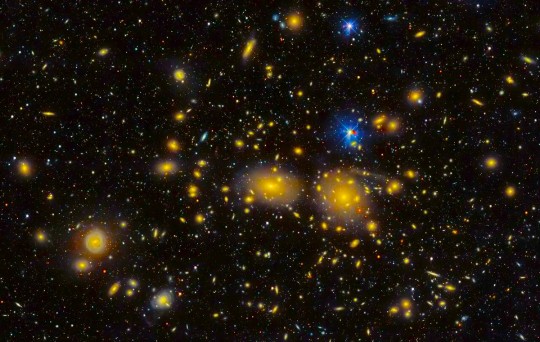
View On WordPress
#Astronomy#Coma Cluster#Hubble Crisis#Hubble Tension#Lambda CDM#LCDM#Local Hubble Constant#New Physics
0 notes
Text
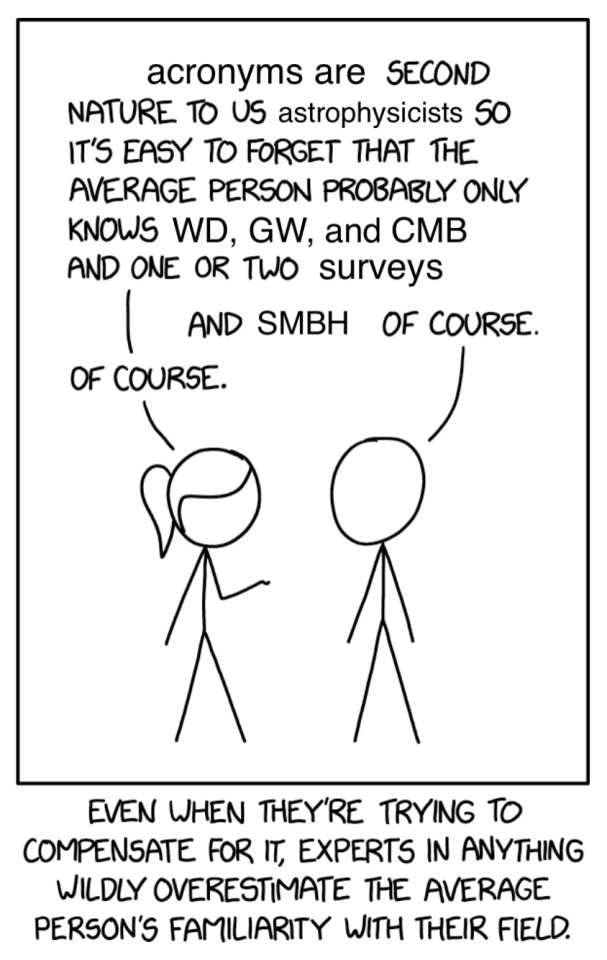
#in honor of the talk on pulsars I was just at where I think everyone except the speaker myself and two others were of the non-astro variety#I was going to write lambda CDM but didn’t have the lambda character#astroposting
85 notes
·
View notes
Text
Ask A Genius 1392: Rethinking the Cosmos: AI, Lambda-CDM, and the Crisis in Big Bang Cosmology
Rick Rosner is an accomplished television writer with credits on shows like Jimmy Kimmel Live!, Crank Yankers, and The Man Show. Over his career, he has earned multiple Writers Guild Award nominations—winning one—and an Emmy nomination. Rosner holds a broad academic background, graduating with the equivalent of eight majors. Based in Los Angeles, he continues to write and develop ideas while…
0 notes
Text
Epistemology at the Heart of Science: Physics and Cosmology
Introducing the Project In contemporary scientific debates, particularly in cosmology, competing theories often emerge that offer divergent interpretations of phenomena such as dark matter, dark energy, or the structure of the universe itself. How do scientists and philosophers rationally adjudicate between them? What makes one theory more credible, elegant, or promising than another, especially…
#Cosmology#Dark Energy#Dark Matter#Einstein-Cartan#Epistemic Virtues#Epistemology#History of Science#Lambda-CDM#Philosophy and Physics#Philosophy of Science#Scientific Theory Choice
0 notes
Text
Senza materia oscura e senza modello standard
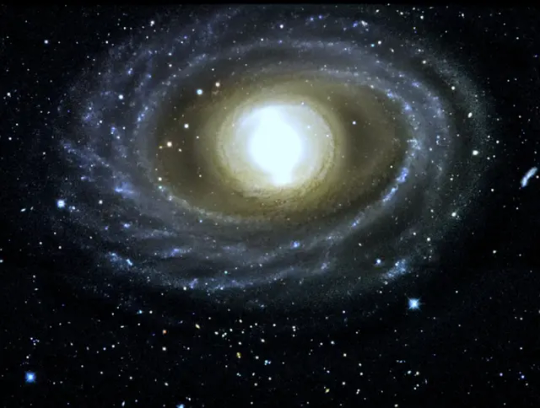
Il James Webb non conferma il Modello Standard. Le galassie nell’Universo primordiale sono nate, evolute e cresciute più rapidamente di quello che le attuali teorie ammettono. Le predizioni fatte dal ‘Lambda- Cold Dark Matter‘, il modello cosmologico teorico più condiviso dalla comunità astronomica, non collimano con le scansioni dell’Universo profondo fatte soprattutto dal James Webb, ma anche da osservazioni precedenti di telescopi come Sptizer, Alma e Hubble, che avevano già acceso i primi, timidi, dubbi. Questo il tema di uno studio pubblicato di recente su The Astrophysical Journal, al quale ha preso parte anche l’Istituto Nazionale di Astrofisica, in cui si evidenzia e analizza la discrepanza , sempre più presente man mano che scrutiamo l’Universo nel profondo della sua genesi. I dati fotometrici sono consistenti con l’esistenza di alcune galassie giganti risalenti a circa 13,2 miliardi di anni fa (redshift z≳10), ma secondo la teoria ‘Lambda-Cdm’, nota anche come ‘Modello Standard‘, strutture di quelle dimensioni non esistevano ancora in quella fase dell’evoluzione cosmica. Secondo questo modello, infatti, le prime galassie di allora non erano affatto gigantesche, ma piuttosto piccole. Si formavano negli aloni di materia oscura, nati a loro volta da fluttuazioni primordiali della densità ed anch’essi inizialmente piccoli. Poi iniziarono a crescere, fondendosi tra loro fino a diventare strutture immense. L’espansione di questi aloni corrispondeva con quella delle galassie al loro interno, che le unioni rendevano sempre più massive. L’estensione delle galassie primordiali quindi, in accordo con la teoria standard, è anche conseguenza del processo aggregativo favorito dalla materia oscura, che però impiega tempi molto più lunghi di quelli che le osservazioni mostrano. Per la ‘Lambda-Cdm’ le galassie primordiali scoperte dai telescopi non dovrebbero stare là, ma apparire in una fase evolutiva successiva.
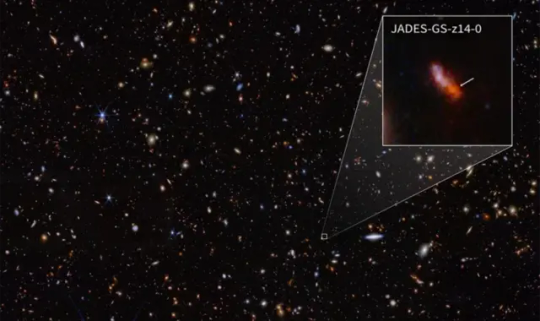
Lo studio però fa notare che esiste una teoria cosmologica alternativa, discussa da molti anni e generalmente considerata meno valida della Lambda-Cdm, che in questo caso risponde benissimo alle osservazioni. Chiamata ‘Mond‘ (Modified Newtonian Dynamics), è nata una quarantina di anni fa modificando la dinamica newtoniana e fa una descrizione diversa della storia dell’Universo. La sua caratteristica principale la rende molto attraente e interessante, perché spiega la meccanica del Cosmo senza ricorrere all’esistenza della materia oscura. Quest’ultima, sappiamo, è una vera e propria ‘invenzione’ degli scienziati per tentare di spiegare le differenze tra le predizioni sull’azione della gravità e le misurazioni effettive. Sebbene sia una componente fondamentale del Modello Standard, da decenni molti scienziati mettono in dubbio la sua reale esistenza. La materia oscura costituirebbe la maggior parte della massa dell’Universo ma è totalmente invisibile, la sua presenza non si può osservare direttamente, in alcun modo. Essendo impossibile rilevarla con qualsiasi strumento a nostra disposizione, le uniche ‘prove’ a supporto della sua esistenza sono una serie di ricadute misurabili che esercita sulla massa visibile, influendone il comportamento. Come accennato, la ‘Mond’ invece offre un quadro cosmologico che non prevede l’esistenza della materia oscura, allo stesso tempo ammette la formazione e l’espansione più rapida delle galassie, rispetto al Modello Standard. Per questa e altre ragioni, più tempo passa più la Mond si dimostra fedele a ciò che i telescopi ci stanno rivelando mentre sondano l’Universo nelle prime fasi dopo il Big Bang. Il sospetto che il James Webb Telescope avrebbe portato innovazioni importanti, e che potesse essere anche in grado di riscrivere le nostre conoscenze di Cosmologia, era già diffuso ancor prima del suo lancio. Che arrivasse persino a mettere in discussione il Modello Standard era invece meno previsto, ciò che ha catturato in questi anni è per molti versi già ampiamente innovativo e sorprendente, oltre che affascinante. Vedremo se sarà anche rivoluzionario. Foto: Immagine dello Spazio Profondo ripreso dal telescopio spaziale Jwst. Quasi ogni oggetto visibile è una galassia remota, distante vari miliardi di anni luce da noi. Una di queste, ingrandita nel riquadro, è ‘Jades-Gs-z14-o’, la galassia più lontana mai scoperta da quando si osserva il cielo. Il Webb ce la mostra come appariva circa 290 milioni di anni dopo il Big Bang. Crediti: Nasa, Esa, Csa, Stsci, B. Robertson (Uc Santa Cruz), B. Johnson (CfA), S. Tacchella (Cambridge), P. Cargile (CfA) Read the full article
0 notes
Text
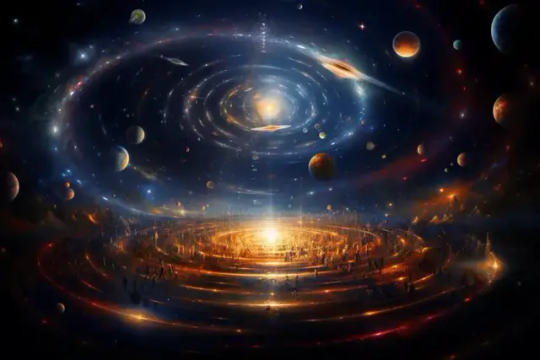
Cosmic Paradigm Shift: New Research Doubles Universe’s Age to 26.7 Billion Years
A new study proposes that the universe may be 26.7 billion years old, challenging the widely accepted estimate of 13.7 billion years based on the Lambda-CDM concordance model.
Our universe could be twice as old as current estimates, according to a new study that challenges the dominant cosmological model and sheds new light on the so-called “impossible early galaxy problem.
For years, astronomers and physicists have calculated the age of our universe by measuring the time elapsed since the Big Bang and by studying the oldest stars based on the redshift of light coming from distant galaxies. In 2021, thanks to new techniques and advances in technology, the age of our universe was thus estimated at 13.797 billion years using the Lambda-CDM concordance model.
However, many scientists have been puzzled by the existence of stars like the Methuselah that appear to be older than the estimated age of our universe and by the discovery of early galaxies in an advanced state of evolution made possible by the James Webb Space Telescope. These galaxies, existing a mere 300 million years or so after the Big Bang, appear to have a level of maturity and mass typically associated with billions of years of cosmic evolution. Furthermore, they’re surprisingly small in size, adding another layer of mystery to the equation.
Some theories like Zwicky's ''tired light'' theory, and Paul Dirac's ''coupling constants'' may be one of the possible explanations and putting the ''cosmological constant'' under possible revision.
source
#jwst#jameswebb#telescope#cosmologia#cosmology#space#universe#universo#astronomy#astronomia#physics#fisica#bigbang#energiaescura#darkenergy#galaxies#stars
841 notes
·
View notes
Text
A UNIVERSE WITHOUT DARK MATTER??
Blog#515
Saturday, June 21st, 2025,
Welcome back,
Our current picture of the cosmos is one of an expanding universe governed by gravity, born from a hot beginning and stretched uniformly across vast scales. But this vision only holds together when we invoke mysterious unseen forces—inflation, dark energy, and more. This prevailing cosmological model—also known as the Big Bang or Lambda-CDM (ΛCDM)—has countless problems, but it is mainstream, and almost all the scientific and economic efforts of the community of astrophysicists and theoretical physicists dealing with the question are focused on the search for evidence that can confirm it.

Other models explaining the cosmos—for example those without a Big Bang beginning, without an inflationary period, without energy and dark matter—do not receive the same attention. But if any of them are correct, the cosmos could be very different from the mainstream version we have been taught as dogma.
The existence of dark or invisible matter detectable only through its gravitational influence has been known by astronomers for a long time now.

In 1844, Friedrich Wilhelm Bessel argued that the observed proper motions of the stars Sirius and Procyon could be explained only in terms of the presence of faint companion stars. In 1846, Urbain Jean Joseph Le Verrier and John Couch Adams independently predicted the existence of Neptune based on calculations of the anomalous motions of Uranus. Le Verrier later proposed the existence of the planet Vulcan to explain anomalies in the orbit of Mercury, but he failed on that occasion because the solution was not invisible matter but a change of gravitational laws, as was solved years later by Einstein with General Relativity.

In 1933, Swiss astronomer Fritz Zwicky was studying rich clusters of galaxies—large clusters containing hundreds or thousands of individual galaxies. He applied the virial theorem to calculate how much matter should be present based on the gravitational forces needed to hold these clusters together. There appeared to be about 60 times more matter than could be accounted for by all the visible stars and gas. In 1939, Horace W. Babcock first showed the need for dark matter for an individual galaxy by measuring how fast stars were rotating in the outer regions of the M31 galaxy, also known as Andromeda. The rotational velocity was faster than it should have been based on visible matter. At that time, however, the majority of astronomers were not yet convinced of the need for dark matter haloes in galaxies.
Originally published on https://iai.tv
COMING UP!!
(Wednesday, June 25th, 2025)
"IS THERE A GALAXY WITHOUT DARK MATTER??"
#astronomy#outer space#alternate universe#astrophysics#universe#spacecraft#white universe#space#parallel universe#astrophotography
18 notes
·
View notes
Text

An article published in the journal "Nature" reports the discovery of three ultramassive galaxies in the early universe in which stars are forming with an efficiency almost twice that of galaxies of average mass by the standards of that era. A team of researchers coordinated by the University of Geneva (UNIGE) used observations conducted with the James Webb space telescope within the FRESCO program. The three galaxies (Image NASA/CSA/ESA, M. Xiao & P. A. Oesch (University of Geneva), G. Brammer (Niels Bohr Institute), Dawn JWST Archive), which were cataloged as S1, S2, and S3, are almost as massive as the Milky Way and add to others that were discovered in recent years and are difficult to explain with the most accepted cosmological models, starting with lambda-CDM.
19 notes
·
View notes
Text



New DESI results strengthen hints that dark energy may evolve
The Dark Energy Spectroscopic Instrument used millions of galaxies and quasars to build the largest 3D map of our universe to date. Combining the DESI data with other experiments shows signs that the impact of dark energy may be weakening over time
The fate of the universe hinges on the balance between matter and dark energy: the fundamental ingredient that drives its accelerating expansion. New results from the Dark Energy Spectroscopic Instrument (DESI) collaboration use the largest 3D map of our universe ever made to track dark energy’s influence over the past 11 billion years. Researchers see hints that dark energy, widely thought to be a “cosmological constant,” might be evolving over time in unexpected ways.
DESI is an international experiment with more than 900 researchers from over 70 institutions around the world and is managed by the U.S. Department of Energy’s Lawrence Berkeley National Laboratory (Berkeley Lab). The collaboration shared their findings today in multiple papers that will be posted on the online repository arXiv and in a presentation at the American Physical Society’s Global Physics Summit in Anaheim, California.
“What we are seeing is deeply intriguing,” said Alexie Leauthaud-Harnett, co-spokesperson for DESI and a professor at UC Santa Cruz. “It is exciting to think that we may be on the cusp of a major discovery about dark energy and the fundamental nature of our universe.”
Taken alone, DESI’s data are consistent with our standard model of the universe: Lambda CDM (where CDM is cold dark matter and Lambda represents the simplest case of dark energy, where it acts as a cosmological constant). However, when paired with other measurements, there are mounting indications that the impact of dark energy may be weakening over time and that other models may be a better fit. Those other measurements include the light leftover from the dawn of the universe (the cosmic microwave background or CMB), exploding stars (supernovae), and how light from distant galaxies is warped by gravity (weak lensing).
“We’re guided by Occam’s razor, and the simplest explanation for what we see is shifting,” said Will Percival, co-spokesperson for DESI and a professor at the University of Waterloo. “It’s looking more and more like we may need to modify our standard model of cosmology to make these different datasets make sense together — and evolving dark energy seems promising.”
So far, the preference for an evolving dark energy has not risen to “5 sigma,” the gold standard in physics that represents the threshold for a discovery. However, different combinations of DESI data with the CMB, weak lensing, and supernovae datasets range from 2.8 to 4.2 sigma. (A 3-sigma event has a 0.3% chance of being a statistical fluke, but many 3-sigma events in physics have faded away with more data.) The analysis used a technique to hide the results from the scientists until the end, mitigating any unconscious bias about the data.
“We're in the business of letting the universe tell us how it works, and maybe the universe is telling us it's more complicated than we thought it was,” said Andrei Cuceu, a postdoctoral researcher at Berkeley Lab and co-chair of DESI’s Lyman-alpha working group, which uses the distribution of intergalactic hydrogen gas to map the distant universe. “It's interesting and gives us more confidence to see that many different lines of evidence are pointing in the same direction.”
DESI is one of the most extensive surveys of the cosmos ever conducted. The state-of-the-art instrument, which capture light from 5,000 galaxies simultaneously, was constructed and is operated with funding from the DOE Office of Science. DESI is mounted on the U.S. National Science Foundation’s Nicholas U. Mayall 4-meter Telescope at Kitt Peak National Observatory (a program of NSF NOIRLab) in Arizona. The experiment is now in its fourth of five years surveying the sky, with plans to measure roughly 50 million galaxies and quasars (extremely distant yet bright objects with black holes at their cores) by the time the project ends.
The new analysis uses data from the first three years of observations and includes nearly 15 million of the best measured galaxies and quasars. It’s a major leap forward, improving the experiment’s precision with a dataset that is more than double what was used in DESI’s first analysis, which also hinted at an evolving dark energy.
“It’s not just that the data continue to show a preference for evolving dark energy, but that the evidence is stronger now than it was,” said Seshadri Nadathur, professor at the University of Portsmouth and co-chair of DESI’s Galaxy and Quasar Clustering working group. “We’ve also performed many additional tests compared to the first year, and they’re making us confident that the results aren't driven by some unknown effect in the data that we haven't accounted for.”
DESI tracks dark energy’s influence by studying how matter is spread across the universe. Events in the very early universe left subtle patterns in how matter is distributed, a feature called baryon acoustic oscillations (BAO). That BAO pattern acts as a standard ruler, with its size at different times directly affected by how the universe was expanding. Measuring the ruler at different distances shows researchers the strength of dark energy throughout history. DESI’s precision with this approach is the best in the world.
“For a couple of decades, we’ve had this standard model of cosmology that is really impressive,” said Willem Elbers, a postdoctoral researcher at Durham University and co-chair of DESI’s Cosmological Parameter Estimation working group, which works out the numbers that describe our universe. “As our data are getting more and more precise, we’re finding potential cracks in the model and realizing we may need something new to explain all the results together.”
The collaboration will soon begin work on additional analyses to extract even more information from the current dataset, and DESI will continue collecting data. Other experiments coming online over the next several years will also provide complementary datasets for future analyses.
“Our results are fertile ground for our theory colleagues as they look at new and existing models, and we’re excited to see what they come up with,” said Michael Levi, DESI director and a scientist at Berkeley Lab. "Whatever the nature of dark energy is, it will shape the future of our universe. It's pretty remarkable that we can look up at the sky with our telescopes and try to answer one of the biggest questions that humanity has ever asked.”
TOP IMAGE: DESI maps distant objects to study dark energy. The instrument is installed on the Mayall Telescope, shown here beneath star trails. Credit KPNO/NOIRLab/NSF/AURA/B. Tafreshi
CENTRE IMAGE: From its mountaintop location in Arizona, DESI maps the universe. Credit Marilyn Sargent/Berkeley Lab
LOWER IMAGE: DESI is a state-of-the-art instrument and can capture light from up to 5,000 celestial objects simultaneously. Credit Marilyn Sargent/Berkeley Lab
8 notes
·
View notes
Text
Huenie: What's something that no matter how it's explained to you, you just can't understand how it works?
Taehyun: Space, it's so big that it is unfathomable and I think it's expanding?! Into what? How did it start? It's all a mindfuck.
Yeonjun: "Into what ?" well that'll haunt me.
Beomgyu: Yeah, thanks for sharing that nightmare.
Taehyun: It's where mathematics is useful. We model the universe with the Lambda-CDM model, which uses a field called differential geometry. This allows you to talk about the universe intrinsically without having to place it in some ambient space: it doesn't need anywhere to grow into.
Soobin: See, I understand each individual word.
#space#txt#tomorrow x together#tomorrow by together#txt incorrect texts#txt incorrect quotes#incorrect kpop quotes#beomgyu#yeonjun#hueningkai#taehyun#soobin#Tomorrow x Together#kpop#reddit comment
18 notes
·
View notes
Text
The Fate of the Universe Hangs in the Balance!
Okay, so it’s a clickbait title. Sue me. But the fate of the universe is hanging in the balance! You see, in recent decades the reigning scientific cosmological theory, the Lambda cold dark matter model (Lambda-CDM for short), has suggested that the physical universe started with a Big Bang that was so energetic that the universe will keep expanding forever, resulting in the eventual heat death…
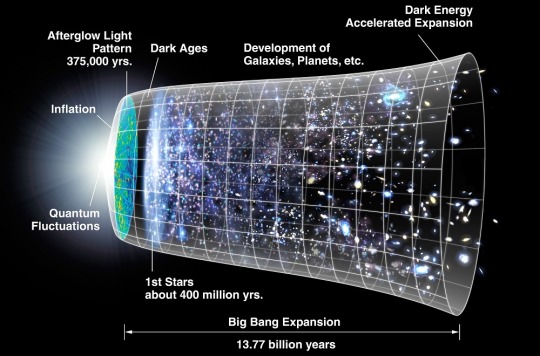
View On WordPress
#Big Crunch#Big Freeze#cosmology#Emanuel Swedenborg#God#heaven#limbus#nature#science#the big bang#the universe
0 notes
Text
Ask A Genius 1392: Rethinking the Cosmos: AI, Lambda-CDM, and the Crisis in Big Bang Cosmology
Author(s): Rick Rosner and Scott Douglas Jacobsen Publication (Outlet/Website): Ask A Genius Publication Date (yyyy/mm/dd): 2025/05/28 ]Rick Rosner is an accomplished television writer with credits on shows like Jimmy Kimmel Live!, Crank Yankers, and The Man Show. Over his career, he has earned multiple Writers Guild Award nominations—winning one—and an Emmy nomination. Rosner holds a broad…
0 notes
Video
youtube
SERÁ QUE O UNIVERSO REALMENTE PRECISA DA MATÉRIA ESCURA?
VISITE A NOVA SPACE TODAY STORE E ADQUIRA A SUA COLEÇÃO EM HOMENAGEM AOS 10 ANOS DE INTERESTELAR!!! https://www.spacetodaystore.com.br/kit-10-anos-interestelar-com-4-camisetas-preta BAIXE E SE INSCREVA GRATUITAMENTE NO SPACE TODAY PLUS!!! https://app.spacetoday.com.br/CADASTRO A energia escura tem sido um pilar fundamental na cosmologia contemporânea, descrita como uma força misteriosa que impulsiona a expansão acelerada do universo. Este conceito, embora enigmático, é amplamente aceito como uma explicação para fenômenos observados que desafiam as leis conhecidas da física. A importância da energia escura reside em sua contribuição para o modelo cosmológico padrão, onde se estima que ela compreenda aproximadamente 70% da composição total do universo. A compreensão dessa força invisível é crucial para desvelar o mistério de como o universo evolui e se expande. O conceito de energia escura emergiu no final do século XX, particularmente a partir das observações revolucionárias realizadas em 1998. Naquele ano, astrônomos que estudavam o brilho de supernovas do tipo Ia em galáxias distantes notaram que o universo não apenas estava se expandindo, mas o fazia de maneira acelerada. Esta descoberta desafiou a expectativa de que a gravidade deveria retardar a expansão universal. Para explicar este fenômeno, cientistas propuseram a existência de uma forma de energia que contrabalançava a gravidade, denominada energia escura. Este conceito foi integrado ao modelo lambda-CDM (Lambda-Cold Dark Matter), que combina energia escura com matéria escura “fria” para descrever a estrutura e a evolução do cosmos. Apesar do sucesso inicial, o modelo padrão de expansão do universo enfrenta desafios significativos que levantam dúvidas sobre a natureza da energia escura. Um desses desafios é a chamada “tensão de Hubble”, uma discrepância entre as taxas de expansão atuais e as inferidas a partir do fundo cósmico de micro-ondas, o resíduo do Big Bang. Além disso, as observações do Instrumento Espectroscópico de Energia Escura (DESI) sugerem que o modelo lambda-CDM pode não ser tão preciso quanto modelos alternativos que consideram uma evolução da energia escura ao longo do tempo. Estas incongruências indicam que a nossa compreensão do universo pode estar incompleta ou errada, instigando a busca por novos modelos que melhor expliquem as observações cosmológicas. O modelo timescape emerge como uma alternativa inovadora ao conceito de energia escura, desafiando a noção tradicional de um universo em expansão uniforme. Proposto pelos pesquisadores da Universidade de Canterbury, este modelo sugere que a aceleração observada na expansão do universo pode ser explicada sem a necessidade de uma força misteriosa como a energia escura. As evidências que suportam o modelo timescape vêm de uma análise mais refinada das observações de supernovas do tipo Ia, que foram inicialmente mal interpretadas em 1998. Em vez de indicar uma aceleração uniforme, essas observações podem ser compatíveis com um universo onde o tempo se comporta de maneira não uniforme. Essa abordagem explica a discrepância entre os dados do Cosmic Microwave Background e as medições atuais de expansão, conhecidas como "Hubble tension". O modelo também aborda a inadequação do modelo lambda-CDM, que não se ajusta bem a dados recentes do Instrumento Espectroscópico de Energia Escura (DESI). O satélite Euclid da Agência Espacial Europeia (ESA) desempenhará um papel crucial na validação do modelo timescape. Previsto para realizar medições precisas da geometria do universo, o Euclid poderia fornecer dados que corroboram ou refutam a estrutura "lumpy" sugerida. Este satélite tem o potencial de revolucionar nossa compreensão cosmológica, oferecendo uma oportunidade sem precedentes para observar a expansão do universo de novas maneiras. Em conclusão, o modelo timescape representa uma possível mudança de paradigma na cosmologia, desafiando a necessidade da energia escura e propondo uma visão mais complexa e dinâmica do cosmos. Se validado, este modelo não apenas transformará nosso entendimento teórico, mas também influenciará a direção da pesquisa cosmológica e astrofísica nas próximas décadas. Fonte: https://www.discovermagazine.com/the-sciences/dark-energy-debunked-by-lumpy-universe-expansion #DARKENERGY #UNIVERSE #EXPANSION
0 notes
Text
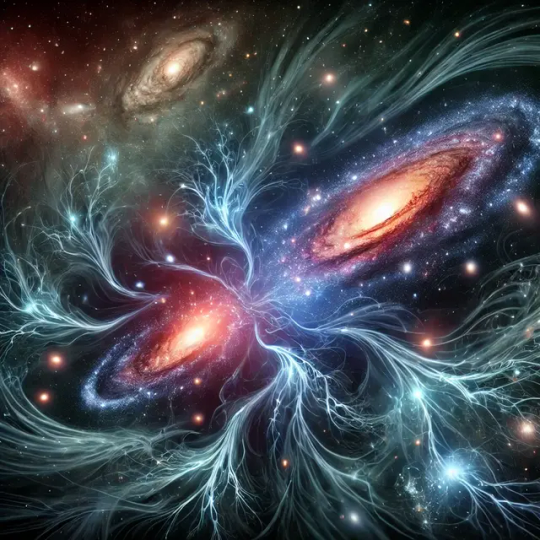
Another Jump in Astrophysics
Early Galaxies Challenging Dark Matter Models, astrophysics has always been rife with surprising discoveries, and the latest findings from cutting-edge telescope data are no exception. Recent observations have cast doubt on some long-held assumptions about the formation of the early universe, leading scientists to question whether our current cosmological models, including the standard ΛCDM (Lambda Cold Dark Matter) model, truly represent the intricacies of cosmic evolution. A Glimpse into Early Galaxies
Data from advanced telescopes, like the James Webb Space Telescope (JWST), has shown that early galaxies, formed less than a billion years after the Big Bang, were much larger and more luminous than previously believed possible. According to traditional models, galaxies were expected to grow more gradually, accruing mass and light over billions of years. The revelation that such massive and bright galaxies existed so early in the universe’s history has prompted a reevaluation of the ΛCDM model.
The Standard ΛCDM Model: A Quick Overview
The ΛCDM model is a mathematical framework that has long been the backbone of Big Bang cosmology. It consists of three main components:
A cosmological constant (Λ): This represents dark energy, an enigmatic force driving the universe's accelerated expansion.
Cold dark matter (CDM): Hypothetical matter that does not emit or interact with electromagnetic radiation, explaining the unseen mass that affects gravitational forces on large scales.
Ordinary matter: The familiar atoms and particles that makeup stars, planets, and everything else visible in the universe.
This model is called the standard cosmology model because it is the simplest and most comprehensive framework that has so far provided a reasonable explanation for a wide range of astronomical observations, from the cosmic microwave background to the distribution of galaxies.
Early Challenges and New Theories
However, the discovery of unexpectedly large and bright early galaxies implies that our models might be missing key details about the dynamics of the early universe. If galaxies formed so rapidly after the Big Bang, alternative explanations may be necessary. These might include modifications to our understanding of gravitational interactions on cosmic scales or the introduction of new interactions between particles that do not fit into the current ΛCDM framework.
Some astrophysicists are exploring models that propose dark matter behaves differently in the presence of extreme conditions, while others suggest entirely new mechanisms that accelerate the process of galaxy formation. These theories challenge the conventional narrative by suggesting that dark matter might not be a universal constant, or that additional factors, such as modified gravity theories, might come into play.
The Future of Cosmological Exploration
As these observations continue to be studied and debated, it is clear that our current cosmological models may need to be updated or expanded to align with this unexpected data. The insights gained from the JWST and similar telescopes will undoubtedly continue to push the boundaries of our understanding, leading to new theories that could redefine our comprehension of the universe’s origins and its early development.
The journey of discovery is far from over, and the universe, as always, holds more mysteries yet to be revealed. Whether these findings lead to small adjustments in the ΛCDM model or prompt the development of entirely new paradigms, one thing is certain: astrophysics is entering an exciting new chapter.
0 notes
Text
Dark Energy
Dark energy, what is it? Let’s take a closer look. In physical cosmology and astronomy dark energy is a proposed form of energy that effects the universe on the largest scale. Its primary effects is the driving force to the expansion of the universe. If we look at the Lambda CDM model, of cosmology and it is correct that dark energy, dominates the universe; contributing of 68 percent of the total…
0 notes
Text
1 note
·
View note